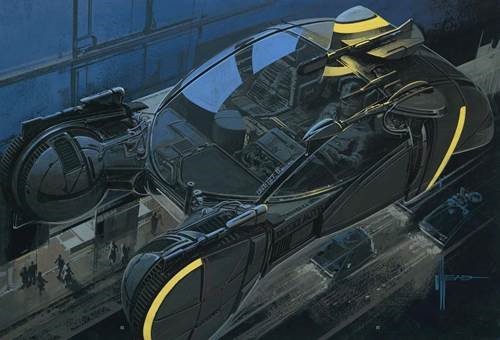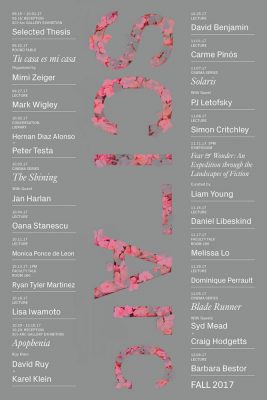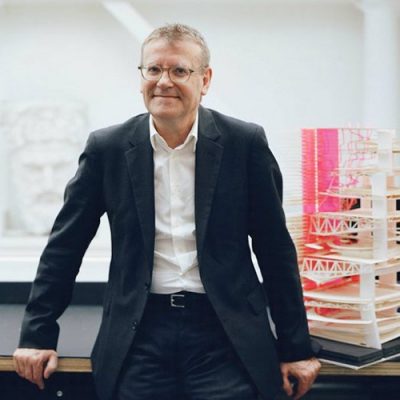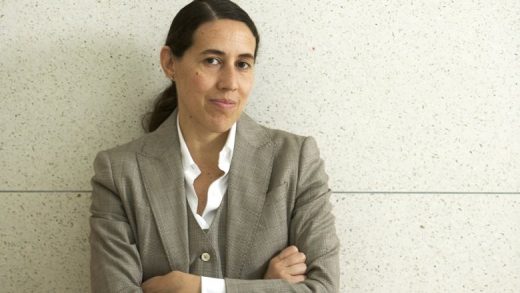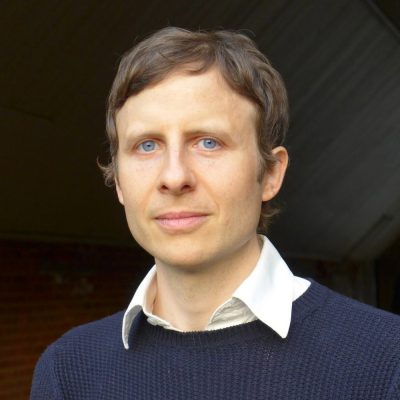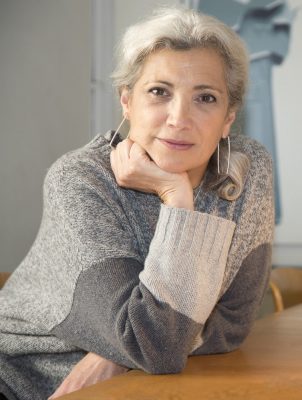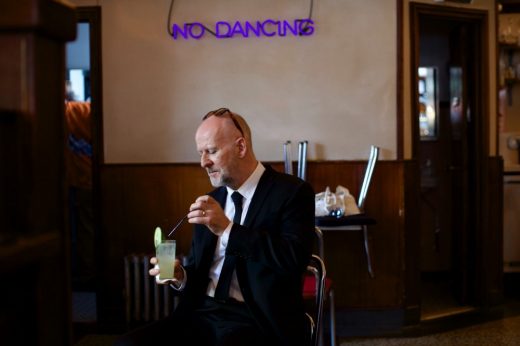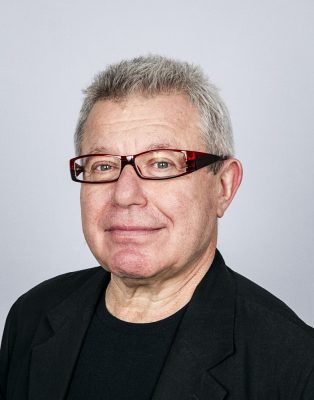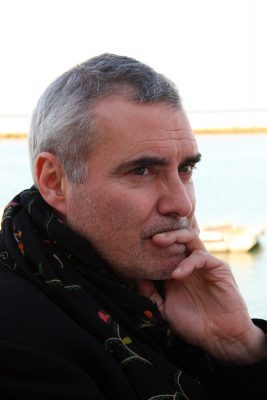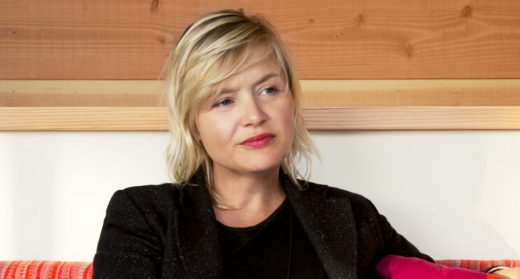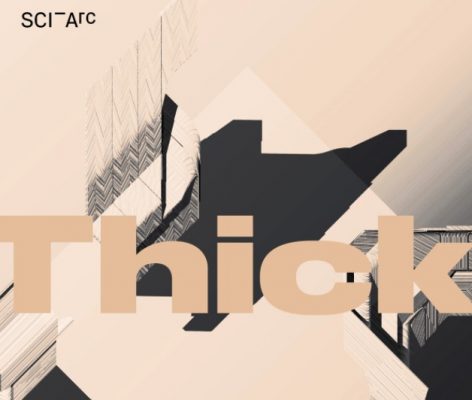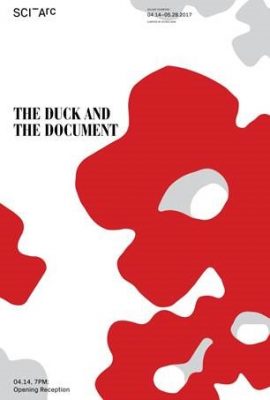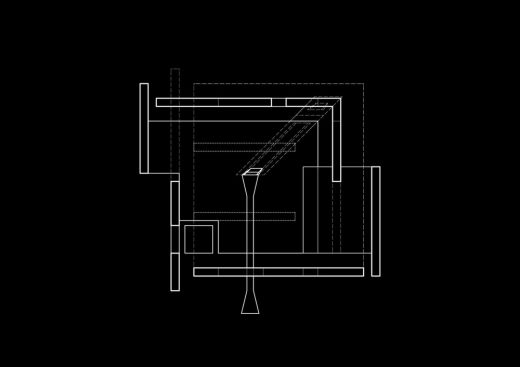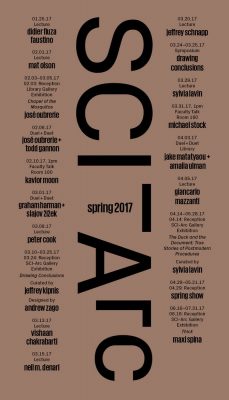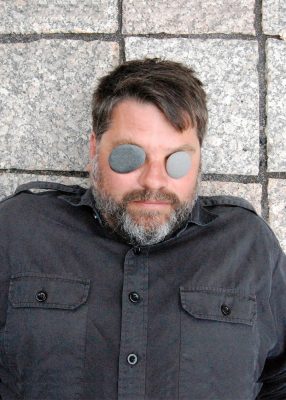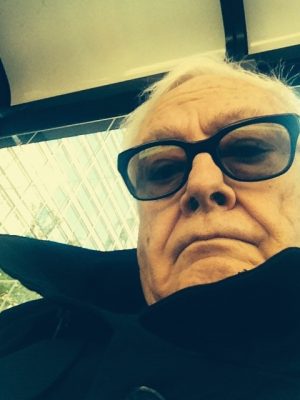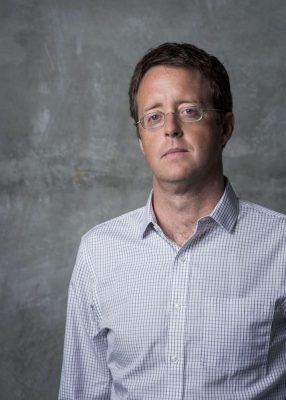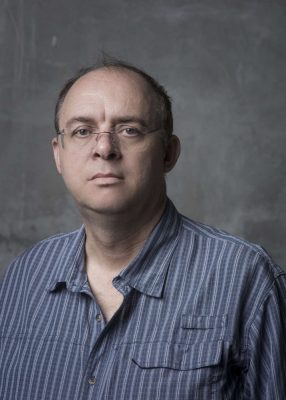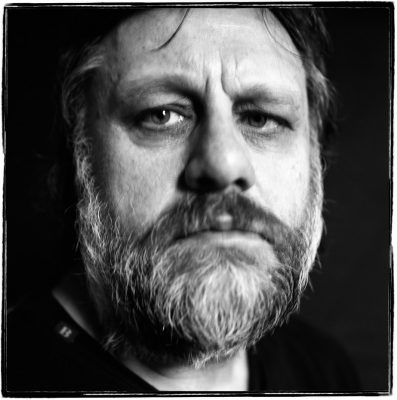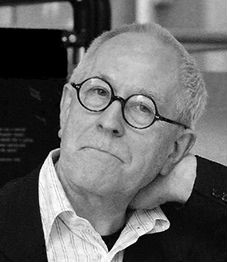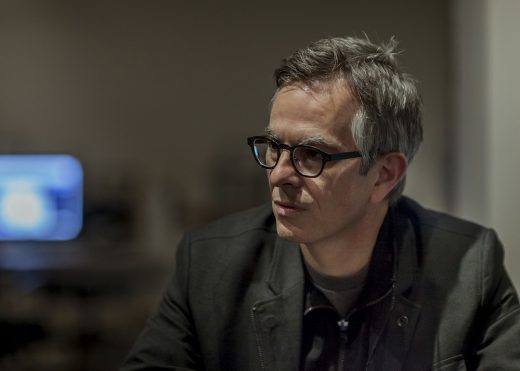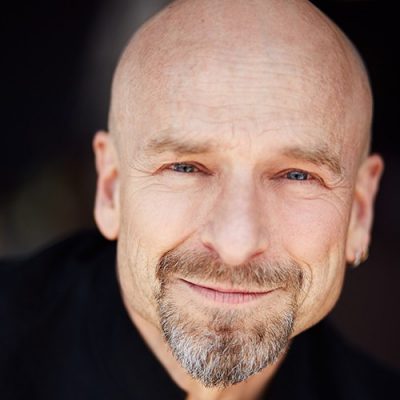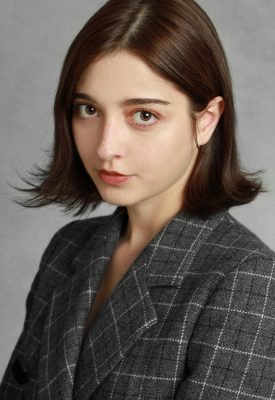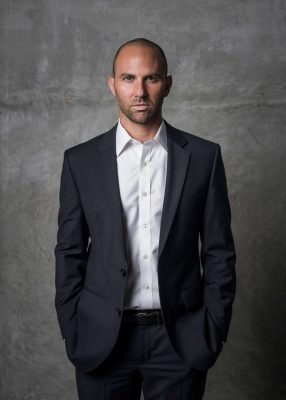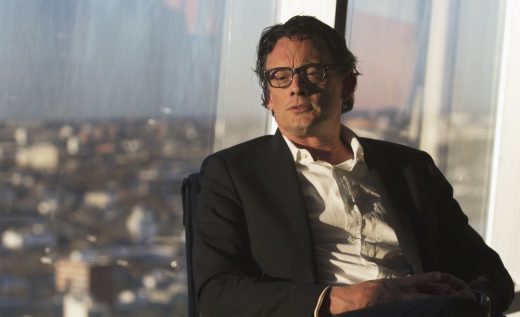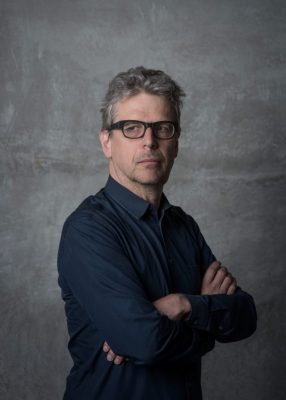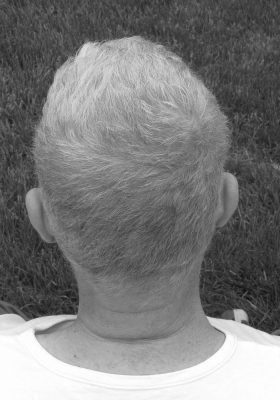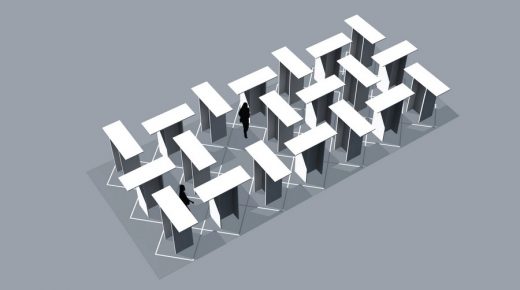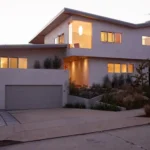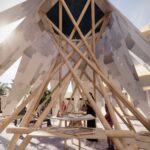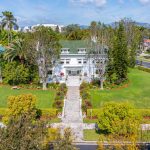SCI-Arc architecture events and lectures, CA exhibitions, Los Angeles architects talks
SCI-Arc Events 2017, Los Angeles
Southern California Institute of Architecture, California, USA: Exhibition + Events
SCI-Arc Events 2017 Archive
SCI-Arc Events 2018 – Spring series of public lectures
Dec 13, 2017
SCI-Arc Announces Marrikka Trotter as History + Theory Coordinator
Los Angeles, CA (December 13, 2017) – SCI-Arc Director Hernan Diaz Alonso is pleased to announce the appointment of Marrikka Trotter as full-time faculty member and Coordinator of History + Theory.
Marrikka Trotter:
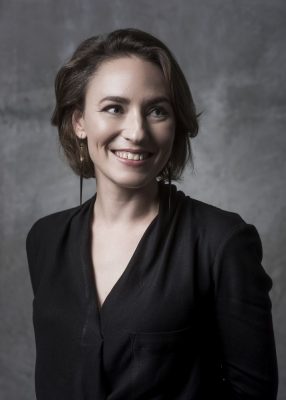
photo by Michal Czerwonka
Trotter is an architectural historian and theorist whose research examines the intersections between geology, architecture, and landscape. She is co-editor of the contemporary architectural theory collections Architecture at the Edge of Everything Else and Architecture is All Over, and her writing has appeared in publications such as Harvard Design Magazine, Log, and AA Files.
She received her PhD from Harvard University, and her work has received funding from the Paul Mellon Centre for Studies in British Art, the Graham Foundation, the Canadian Centre for Architecture, and Sir John Soane’s Museum.
“SCI-Arc is an experimental school that rewards speculative risk-taking,” Trotter notes. “I want this to be reflected in the way we approach history and theory.”
“SCI-Arc is driven by change and people who don’t operate within the confines of tradition,” says Hernan Diaz Alonso, SCI-Arc Director/CEO. “Marrikka’s approach exemplifies this commitment and we look forward to seeing how she will push the school’s discourse into new trajectories.”
Previously on e-architect:
Nov 21, 2017
SCI-Arc Hosts Renown SCI-Fi Designer Syd Mead in Conversation with Architect Craig Hodgetts
Join on Tuesday, December 5 at 7pm in the W.M. Keck Lecture Hall for a conversation and celebration of the publication of The Movie Art of Syd Mead: Visual Futurist followed by a screening of Aliens
Los Angeles, CA (November 21, 2017) – Renown science-fiction designer Syd Mead, whose designs for the film Blade Runner created an instantaneous movie genre, will celebrate the publication of his book The Movie Art of Syd Mead: Visual Futurist in a conversation with architect Craig Hodgetts on December 5 at SCI-Arc (7pm). Discussing their year-long collaboration on the book, which chronicles Mead’s drawings for such films as Aliens and Star Trek, Hodgetts and Mead will delve into the origins of the imagery, the technology and the often revealing relationships between Mead and the directors and writers he has worked with during his fifty year career.
Hodgetts and Mead first met at a film and architecture conference more than twenty years ago and found common ground in their zeal for the future. At the time, Hodgetts was trying to find backers for a film based on the book Ectopia, and had just completed construction of a futuristic library on the campus of UCLA.
That began a friendship in which Mead would drop by Hodgetts’ graduate class at UCLA with inspirational stories and images, while Hodgetts contributed reviews celebrating Mead’s work for various publications.
Hodgetts, an architect best known for the design of the new Hollywood Bowl, and his research into developing technologies such as the Hyperloop, plans to probe the sources, processes and pre-occupations that have resulted in Mead’s hand-drawn renderings, which, in this day of digital imagery, astonish with their masterful handling of light, form and atmosphere.
The book, lavishly illustrated with more than 300 sketches and renderings, accompanied by a descriptive text, captures the insights about Mead’s working methods, his inspirations and frustrations, as well as personal anecdotes about life as a visual futurist.
This will be a rare, once in a generation opportunity to hear and see Syd in one of his few public appearances. A perennial star at Comic-Con and awards shows, his appearance at SCI-Arc will be accompanied by a screening of Aliens, a film he designed in 1986 for director James Cameron, and to acquire an autographed copy of the book from the authors themselves.
The SCI-Arc Cinema Series is free and open to the Public. Shows begin at 7pm in the Keck Auditorium. Popcorn and drinks will be available.
Syd Mead
Sydney Jay Mead was born in St. Paul Minnesota, July 18th, 1933 but spent only a few years there before moving to what would be the second of many homes throughout the western United States prior to graduating from High School in Colorado Springs, Colorado in 1951.
After serving a three year enlistment in the U.S. Army, Syd Mead graduated with great distinction in June of 1959 and was immediately recruited by the Ford Motor Company’s Advanced Styling Studio under the management of Elwood Engle which he left after 2 years in order to accept a variety of assignments travelling the world to illustrate books, catalogues and product designs for large corporate entities including United States Steel, Celanese, Allis Chalmers and Phillips Electronics.
In the 70’s and 80’s he was recruited by several firms to create interior and exterior architectural renderings for such clients as Intercontinental Hotels, 3D International, Harwood Taylor & Associates, Don Ghia, and Gresham & Smith. In 2010, the New York firm of Philip Koether Architects tapped Syd to design the interior of the popular restaurant Bar Basque in Manhattan.
In 1979, the motion picture industry recognized his unique ability to “visualize” the future, his work can be seen in feature films as Blade Runner, Tron, 2010, Short Circuit, Time Cop, Johnny Mnemonic, MP-3 and most recently, Blade Runner 2049 for which he did pre-production art for director Denis Villeneue. In 2016 the Visual Effects Society awarded Syd their top honor reaffirming his title of “Visual Futurist” by his peers and the industry.
Syd has also done concept and design work for a number of major Japanese clients, including; Sony, Minolta, Dentsu, Dyflex, Tiger, Seibu, Mitsukoshi, Bandai, NHK and Honda as well as contributing to two Japanese film projects, He also created designs for two Japanese toy icons, “The New Yamato” and all eight robot characters in the new Turn-A Gundam mobile suite series which are also seen as characters in television shows.
With transportation design as his first love, Syd seldom misses an opportunity to provide his unique blend of futurism and believability to those projects consisting of a vehicle that travels from “A” to ‘B”. Whether it be designing solar powered unicycles, show cars, luxury yachts, interiors of private 747’s, or interplanetary vehicles, each receives the same attention to detail and is part of a perfectly designed scenario.
This approach has become a Syd Mead trademark and can be seen in everything from concept cars for Ford Motor Company to his futuristic “Hyper-vans” currently being referred to by many as the direction of tomorrow’s automotive design. They are clearly evident in Syd’s latest painting created for the poster art to promote this year’s Eyes On Design car classic exhibition held at the Edsel Ford Estate in Grosse Point Shores, Michigan this June 18th, (Fathers’ Day) where Syd was awarded a lifetime design achievement award http://www.eyesondesign.org/2017-vision-honored/.
Syd Mead continues an active schedule of one-man shows. Beginning in Germany in 1973, his work has since been exhibited in Japan, Italy, California, and Spain. In 1983 he was the guest speaker to the design staff at Chrysler Corporation. The resulting presentation was a resounding success and has since been expanded and enhanced with computer generated imagery specifically assembled at the requests of such clients as Disney, Carnegie Mellon University, Purdue, Pratt University, the Society of Illustrators.
In March of 2010, Syd completed a four-city tour in Australia to capacity audiences at each venue. His one man shows, “Cavalcade to the Crimson Castle” and “Progressions” have drawn record crowds in venues across the nation. Syd Mead has published 10 books and instructional DVD’s in association with the Gnomon Workshop Inc. His latest book, The Movie Art of Syd Mead: Visual Futurist published by Titan Press, is available on Amazon.com and better bookstores everywhere.
These days, Syd doesn’t often travel far from his comfortable surroundings in Pasadena, California where when he is not working, he enjoys leisurely driving his 1972 Imperial and working on his autobiography, titled, “A Future Remembered” with his partner of over 30 years, Roger Servick.
Mead attributes success in an astonishing range of creative activities to the premise that imagination…the idea, supersedes technique every time. “There are more people in the world who make things than there are people who think of things to make.” – Syd Mead
Craig Hodgetts
Craig Hodgetts is an architect and inventor, whose multi-faceted career has embraced technical innovation, civil and cultural institutions and visionary urban designs, was educated as an automobile engineer before studtying theater with renown dramaturge Herbert Blau and, later, architecture with James Stirling at Yale’s School of Art and Architecture. Having established a well-regarded avant garde architectural practice in Manhattan, he relocated after two years to Los Angeles to become one of the founders of the California Institute of the Arts.
His first built project, a multimedia toy store on 53rd street in Manhattan, with partners Lester Walker and Robert Mangurian, featured sound and light “games” devised by rising stars Jukes Fisher and Morton Subotnik, earning a front-page article in the Wall Street Journal. Subsequent to the studio’s move to LA their first project for Larry Gagosian, who had yet to emerge as an art world powerhouse was featured in a cover story in Progressive Architecture Magazine and named to a list of twenty-five significant buildings in Southern California.
After a two year hiatus, during which he wrote screenplays and worked as a production designer for renown director Robert Able, where he helped to devise methods to apply computer technology to film-making, and an on-location shoot at Arcosanti with producter Roger Corman, he returned to the practice of architecture with new partner Hsinming Fung.
The firm earned world-wide recognition with their first project, an aluminum and fabric temporary library at UCLA, which exemplified their belief in the role of high technology in architecture. Later significant projects, wuch as their renovation of the Egyptian Theater in Hollywood, which won a national honor award, and the creation of an all-new Hollywood Bowl shell, cemented their reputation for innovative, progressive design.
As leaders of UCLA’s Ideas Laboratory, Hodgetts has initiated studies of everything from autonomous vehicles and cyber-cities to an in-depth exploration of Elon Musk’s Hyperloop concept, and is currently devoting his attention to creating a vision of the Sunset Strip circa 2050.
Aug 16 + 15, 2017
SCI-Arc Fall Events
SCI-ARC ANNOUNCES FALL 2017 PUBLIC LECTURES AND EXHIBITIONS
Events at SCI-Arc are always free and open to the public
Los Angeles, CA (August 15, 2017) – SCI-Arc is pleased to announce its fall 2017 series of public events. SCI-Arc public lectures this coming fall will introduce speakers from a broad cross-section of today’s most exciting architects, artists, philosophers and theorists including Oana Stanescu, Carme Pinós and Simon Critchley, among others. Fear and Wonder: An Expedition through the Landscapes of Fiction, a symposium curated by Liam Young, will join an ensemble of directors, concept artists, video game designers and storytellers for an expedition through an atlas of imaginary worlds, fictional cities and speculative geographies.
The lecture series is complemented by several exhibitions including: the 2017 Selected Thesis Exhibition which will feature the 2017 Gehry Prize winning thesis alongside a selection of best graduate thesis projects. Ruy Klein (David Ruy and Karel Klein), a firm that examines contemporary design problems at the intersection of architecture, nature, and technology, will also exhibit their work in the SCI-Arc Gallery.
Admission to SCI-Arc-hosted public events and exhibitions is always free and open to the public.
September 15 Selected Thesis Exhibition Opening Reception
22 Tu Casa es mi Casa A Roundtable Discussion
27 Mark Wigley Lecture
October 2 Hernan Diaz Alonso and Peter Testa Conversation
4 Oana Stanescu Lecture
11 Monica Ponce de Leon Lecture
18 Lisa Iwamoto Lecture
20 Ruy Klein (David Ruy & Karel Klein):
Apophenia Exhibition Opening Reception
25 David Benjamin Lecture
November 1 Carme Pinós Lecture
8 Simon Critchley Lecture
11 Fear and Wonder Symposium Curated by Liam Young
29 Dominique PerraultLecture
December 6 Barbara Bestor Lecture
Visit https://sciarc.edu/events/ for more information about upcoming lectures. All events begin at 7pm unless otherwise noted. Lectures take place in the W. M. Keck Lecture Hall and are broadcast on the SCI-Arc Facebook page. Gallery opening receptions are held in the SCI-Arc Gallery and Kappe Library Gallery spaces.
LECTURES
September 22, 7pm in the W.M. Keck Lecture Hall
Tu Casa es mi Casa: A Roundtable Discussion
This roundtable brings together Los Angeles and Mexico City–based participants of the exhibition Tu casa es mi casa, on view at the Neutra VDL House, to discuss issues of cross-border exchange, the exigencies of domestic modernism, and contemporary Mexican design practice.
Tu casa es mi casa is produced in collaboration between the Los Angeles Forum for Architecture and Urban Design, Neutra VDL Studio and Residences, Archivo Diseño y Arquitectura. The Neutra VDL Studio and Residences is preserved and managed by the College of Environmental Design (ENV) at Cal Poly Pomona.
Participants include:
Mexican architects: Frida Escobedo, Pedro&Juana: Ana Paula Ruiz Galindo and Mecky Reuss, and Tezontle: Lucas Cantú and Carlos Matos
Angeleno writers: Aris Janigian, David Ulin, and Katya Tylevich
Curators: Mario Ballesteros, Andrea Dietz, Sarah Lorenzen, and Mimi Zeiger
September 27, 7pm in the W.M. Keck Lecture Hall
Mark Wigley Lecture
Mark Wigley is Professor and Dean Emeritus at Columbia GSAPP. He served as Dean from 2004 to 2014. Wigley has written extensively on the theory and practice of architecture and is the author of Constant’s New Babylon: The Hyper-Architecture of Desire (1998); White Walls, Designer Dresses: The Fashioning of Modern Architecture (1995); and The Architecture of Deconstruction: Derrida’s Haunt (1993).
He co-edited The Activist Drawing: Retracing Situationalist Architectures from Constant’s New Babylon to Beyond (2001). In 2005 he co-founded Volume magazine with Rem Koolhaas and Ole Bouman as a collaborative project by Archis (Amsterdam), AMO (Rotterdam), and C-lab (Columbia University). Wigley curated the exhibition Deconstructivist Architecture at The Museum of Modern Art, and others at The Drawing Center, New York; Canadian Centre for Architecture, Montreal; and Witte de With Museum, Rotterdam.
Mark Wigley was awarded the Resident Fellowship, Chicago Institute for Architecture and Urbanism (1989), International Committee of Architectural Critics (C.I.C.A.) Triennial Award for Architectural Criticism (1990) and a Graham Foundation Gran (1997). He received both his Bachelor of Architecture (1979) and his Ph.D. (1987) from the University of Auckland, New Zealand.
October 2, 7pm in the W.M. Keck Lecture Hall
Hernan Diaz Alonso + Peter Testa Conversation
Hernan Diaz Alonso and Peter Testa will discuss, Robot House: Instrumentation, Representation, Fabrication, a new publication by Peter Testa, with Forewords by Greg Lynn, and Eric Moss. Robot House features projects produced by one of the most innovative robotics design studios in the world, often interacting with a wide range of technologies from motion capture to material science—a realm far beyond conventional 3D modeling and the capabilities of 3D printing.
Hernan Diaz Alonso assumed the role of SCI-Arc director beginning in the 2015 academic year. He has been a distinguished faculty member since 2001, serving in several leadership roles, including coordinator of the graduate thesis program from 2007–10, and graduate programs chair from 2010–15. He is widely credited with spearheading SCI-Arc’s transition to digital technologies, and he played a key role in shaping the school’s graduate curriculum over the last decade.
In parallel to his role at SCI-Arc, Diaz Alonso is principal of the Los Angeles–based architecture office Xefirotarch. His multidisciplinary practice is praised for its work at the intersection of design, animation, interactive environments, and radical architectural explorations. Over the course of his career as an architect and educator, Diaz Alonso has earned accolades for his leadership and innovation, as well as his ability to build partnerships among varied constituencies.
Peter Testa is Founding Partner at Testa & Weiser and Senior Design Faculty at SCI-Arc. He was born and raised in Lisbon. Testa holds a Bachelor of Architecture and Master of Science in Architecture (S.M.Arch.S. History/Theory) from the Massachusetts Institute of Technology.
He is a Registered Architect in California. Previously he was Principal-in-Charge with Pritzker Laureate Álvaro Siza. His work is exhibited worldwide and is in the collection of the Canadian Centre for Architecture (CCA). He was Associate Professor of Architecture at Columbia University (1990-1996) and at the Massachusetts Institute of Technology (1996-2002). He has also taught as Visiting Professor at Harvard University, University of Pennsylvania, and University of California.
He is the author of three books on architectural theory and has lectured extensively in the United States and Europe. Testa is the recipient of numerous awards including the MIT Innovation Award, and Design Arts Award of the National Endowment for the Arts.
October 4, 7pm in the W.M. Keck Lecture Hall
Oana Stanescu Lecture
Oana Stanescu:
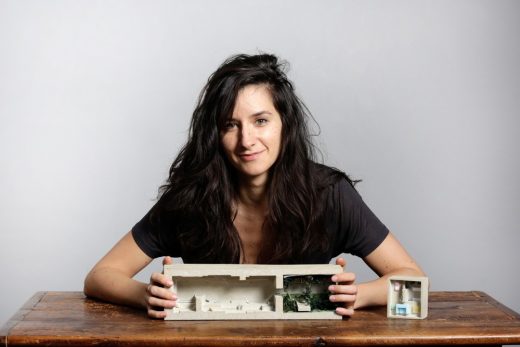
photo courtesy of SCI-Arc
Oana Stanescu co-directs Family New York with Dong-Ping Wong. Family designs environments with the simple purpose of making better places to live. The New York based office is composed of architects, designers and strategists currently working on an array of civic, cultural, commercial and residential projects around the world.
Regardless of type or scale, we believe that buildings, like the people that live and work within them, can actively contribute to making the environments all around us more productive, inspirational and awesome. Our clients and collaborators include The Office of PlayLab, Friends of + POOL, Off-White c/o Virgil Abloh, 2×4, Arup, Nike, Tom Sachs, the New Museum, the Storefront for Art and Architecture and Kanye West.
The first part of the lecture will focus on Family’s goals and the implicit creative process by illustrating a series of built and un-built projects. In the second part we will be discussing through a case study the impact of design, as well as today’s opportunities that allow us to circumvent the traditional architectural process, from inception to opening.
October 11, 7pm in the W.M. Keck Lecture Hall
Monica Ponce de Leon Lecture
Monica Ponce de Leon, a pioneering educator and award-winning architect, is dean of Princeton University’s School of Architecture. Ponce de Leon has served as dean of the Taubman College of Architecture and Urban Planning at the University of Michigan-Ann Arbor from 2008 to 2015, where she is also the Eliel Saarinen Collegiate Professor of Architecture and Urban Planning.
Before her appointment at the University of Michigan, Ponce de Leon was a professor at the Harvard Graduate School of Design, where she served on the faculty for 12 years. A recipient of the prestigious National Design Award in Architecture from the Cooper Hewitt, Smithsonian National Design Museum, Ponce de Leon co-founded Office dA, in 1991, and in 2011 started her own design practice, MPdL Studio, with offices in New York, Boston and Ann Arbor.
MPdL Studio brings together an interdisciplinary team of practitioners with several years of experience working together at the former Office dA. We thrive in the diversity of our backgrounds, as well as the richness and wide range of our skills. With degrees in Fine Arts, Architecture, Material Systems, Environmental Design, Historic Preservation, and Urban Design, each member of our team brings a unique point of view to the design process.
We have extensive experience on institutional projects and have developed methodologies that allow the projects to be on time and on budget while delivering innovative and meaningful design. While MPdL Studio is a relatively new venture established in 2011, the former Office dA was in practice for over twenty years. Our team of 10 designers and administrative staff includes two licensed professionals.
October 18, 7pm in the W.M. Keck Lecture Hall
Lisa Iwomoto Lecture
Lisa Iwamoto is Founding Partner with Craig Scott of IwamotoScott Architecture. IwamotoScott has received numerous awards including the Architectural League’s Emerging Voices and Young Architects, Architectural Record’s Design Vanguard, over twenty AIA Design Awards, a P/A Award and numerous other architecture and interior awards.
Their work has been published in hundreds of journals, and exhibited in over fifty museums and galleries. Lisa received her Master of Architecture degree with Distinction from Harvard University, and a Bachelor of Science degree in Structural Engineering from the University of Colorado. She is author of Digital Fabrications: Architectural and Material Techniques published in 2009 by Princeton Architectural Press, and is Professor at the University of California Berkeley.
In Michael Heizer’s “Double Negative” from 1969, two voids: one, the edge of an existing canyon; the other, a machine-made cut, intersect to infer a third – the double negative. This artwork and the wider spatial implications of the double negative serve as touchstones for our work; we privilege the design of void and volume over syntax and surface.
Unlike earthwork sculpture however, architecture cannot rely upon the mere act of digging to unveil the magical and unified confluence of form, site, space and material. Instead, we grapple with how to create resonance, abstraction and multiple readings using formal geometry and common building materials assembled in innovative ways.
This has become a pervasive question in our work where we try to achieve a unique design synthesis across multiple scales. Lisa Iwamoto will discuss the work of her firm, currently in a moment of transition from installations and speculative proposals toward building.
October 25, 7pm in W.M. Keck Lecture Hall
David Benjamin Lecture
David Benjamin is Founding Principal of The Living and Assistant Professor at Columbia GSAPP. He and the firm have won many design prizes, including the Emerging Voices Award from the Architectural League, the New Practices Award from the AIA New York, the Young Architects Program Award from the Museum of Modern Art and MoMA PS1, and a Holcim Sustainability Award.
Clients include the City of New York, Seoul Municipal Government, Google, Nike, 3M, Airbus, BMW, Miami Science Museum, and Björk. Recent projects include the Princeton Embodied Computation Lab (a new building for research on next-generation architecture technologies), Pier 35 EcoPark (a 200-foot-long floating pier in the East River that changes color according to water quality), and Hy-Fi (a branching tower for MoMA PS1 made of a new type of biodegradable brick).
The Living combines research and practice, exploring new ideas and technologies through prototyping. The studio’s work embraces the complexity at the intersection of ideas, technologies, materials, culture, humans, non-humans, and the environment.
Focusing on the intersection of biology, computation, and design, the studio has articulated three frameworks for harnessing living organisms for architecture: bio-computing, bio-sensing, and bio-manufacturing. The studio welcomes rapid change, embraces design with uncertainty, develops rules rather than forms, and designs with unknowable forces.
November 1, 7pm in the W.M. Keck Lecture Hall
Carme Pinós Lecture
For the last 25 years, Carme Pinós has worked on numerous projects ranging from urban refurbishments and public works to furniture design. Her sharp approach to design, anchored by a constant focus on experimentation and research, has made her work garner worldwide recognition at the same time that Barcelona architecture has cemented its own identity and reputation throughout Europe and South and North America.
Her current projects include the Regional Office of the Generalitat in Tortosa (Spain); the architectural set composed by Gardunya Square in Barcelona; and the Masterplan for the historic centre of Saint Dizier (France). Among her most significant completed recent projects are the Departments Building of the Vienna University of Economics and Business (Austria), the Cube and Cube II Towers in Guadalajara (Mexico), the Caixaforum Cultural and Exhibition Centre in Zaragoza (Spain), the metro station Zona Universitaria in Barcelona and the Crematorium in the Igualada Cemetery (Spain).
Carme Pinós combines work as an architect with teaching and lecturing, and has been guest professor at universities and institutions worldwide, and her work has been widely exhibited.
The Centre Pompidou acquired the scale models of the Caixaforum Zaragoza in Spain, the Hotel Pizota in Mexico, and the Maison de l’Algérie of Paris. The model of the Cube I Tower currently belongs to the collection of New York’s MOMA.
November 8, 7pm in the W.M. Keck Lecture Hall
Simon Critchley Lecture
Simon Critchley is Hans Jonas Professor at the New School for Social Research. His books include Very Little…Almost Nothing (1997), Infinitely Demanding (2007), The Book of Dead Philosophers (2009) and The Faith of the Faithless (2012). Recent works include a novella, Memory Theatre, a book-length essay, Notes on Suicide and a book on David Bowie. He is series moderator of ‘The Stone’, a philosophy column in The New York Times and co-editor of The Stone Reader (2016). He is also 50% of an obscure musical combo called Critchley & Simmons. Ponders End, their new album, was recently released.
November 11, 3pm in the W.M. Keck Lecture Hall
Fear and Wonder: An Expedition through the Landscapes of Fiction, Curated by Liam Young Symposium
Our perception of the world is largely shaped through the mediums of fiction. Our political positions are informed by fake news, we live out our lives in the pixelated territories of video games and we escape into the pages of a novel or the flicker of the movie screen.
In film, games and literature, we have always imagined alternative worlds as a means to understand our own world in new ways. In Fear and Wonder we join an ensemble of directors, concept artists, video game designers and storytellers for an expedition through an atlas of imaginary worlds, fictional cities and speculative geographies.
Liam Young, SCI-Arc Fiction and Entertainment Coordinator and Design Faculty, is an Australian born architect who operates in the spaces between design, fiction and futures. He is founder of the think tank Tomorrows Thoughts Today, a group whose work explores the possibilities of fantastic, speculative and imaginary urbanisms. Building his design fictions from the realities of present, Young also co-runs the Unknown Fields Division, a nomadic research studio that travels on location shoots and expeditions to the ends of the earth to document emerging trends and uncover the weak signals of possible futures. He has been acclaimed in both mainstream and architectural media, including the BBC, NBC, Wired, Guardian, Time Magazine, and Dazed and Confused and his work has been collected by institutions such as the Metropolitan Museum of Art and the Victoria and Albert Museum.
He has taught internationally including the Architectural Association and Princeton University and now runs an M.A. in Fiction and Entertainment at SCI-Arc. Young manages his time between exploring distant landscapes and visualizing the fictional worlds he extrapolates from them.
November 15, 7pm in the W.M. Keck Lecture Hall
Daniel Libeskind Lecture
Polish-American architect, Daniel Libeskind is an international figure in architecture and urban design. Informed by a deep commitment to music, philosophy, and literature, Mr. Libeskind aims to create architecture that is resonant, original, and sustainable. Libeskind established his architectural studio in Berlin, Germany, in 1989 after winning the competition to build the Jewish Museum in Berlin.
In February 2003, Studio Libeskind moved its headquarters from Berlin to New York City to oversee the master planner for the World Trade Center redevelopment, which is being realized in Lower Manhattan today. Daniel Libeskind’s practice is involved in designing and realizing a diverse array of urban, cultural and commercial projects around the globe.
The Studio has completed buildings that range from museums and concert halls to convention centers, university buildings, hotels, shopping centers and residential towers. As Principal Design Architect for Studio Libeskind , Mr. Libeskind speaks widely on the art of architecture in universities and professional summits. His architecture and ideas have been the subject of many articles and exhibitions, influencing the field of architecture and the development of cities and culture.
November 29, 7pm in the W.M. Keck Lecture Hall
Dominique Perrault Lecture
Praemium imperial award winner (Japan), the French architect and urban planner, Dominique Perrault, is a professor and director of the Underground Architecture Laboratory (SUB) at the Ecole Polytechnique Fédérale de Lausanne in Switzerland. He is also the founder of DPAx, a multidisciplinary research platform exploring architecture from a wider perspective, and DPA Lab, a laboratory of research and innovation developing processes that reinvent the vocabulary of architecture.
Along with the Bibliothèque nationale de France, his main projects to date include the Olympic Velodrome and Swimming Pool in Berlin, the extension of the Court of Justice of the European Union in Luxembourg, the Olympic Tennis Stadium in Madrid, the EWHA Woman’s University in Seoul and the Fukoku Tower in Osaka. In recent years, Dominique Perrault inaugurated the tallest tower of Austria in Vienna, the DC Tower 1, and led various heritage rehabilitation projects, including the new public entry pavilion for the Château de Versailles.
Current studies and urban research projects include the Olympic Village – Paris 2024 and the “Mission Ile de la Cité,” an urban study commissioned by the president of the French Republic that reflects upon the future of the thriving, historical center of Paris from now until 2040.
December 5, 7pm in the W.M. Keck Lecture Hall
Barbara Bestor Lecture
Barbara Bestor, FAIA is founding principal of Bestor Architecture. Since 1995, Bestor Architecture has actively redefined Los Angeles architecture with a practice that rigorously engages the city through design, art, and urbanism. Increasingly, the firm applies L.A.’s lessons to national undertakings.
Projects such as Beats by Dre headquarters, Blackbirds small-lot housing development, and Intelligentsia café illustrate Bestor’s continued exploration of architectural form through experimentation, research, and graphics. Bestor is faculty at Woodbury University School of Architecture and executive director of the university’s Julius Shulman Institute. She is author of Bohemian Modern, Living in Silver Lake.
Bestor Architecture is a twenty-five person firm based in Los Angeles. Founded by Barbara Bestor, FAIA in 1995, Bestor Architecture has designed a number of award-winning projects including headquarters for Beats by Dre and Nasty Gal, Blackbirds, a groundbreaking new typology for dense housing in Echo Park, and a variety of experimental residences and commercial establishments.
The varied, creative, and aesthetically progressive body of work expands the territory of architecture into atmospheric urbanism. Recent projects include the Silverlake Conservatory of Music, which creates a vibrant musical haven by inserting an internal urban village within the shell of a classic Hollywood warehouse, a new winery and event center in Napa, and headquarters for multiple high tech firms.
EXHIBITIONS
September 15 – October 1, 2017 in the SCI-Arc Gallery
Selected Thesis Exhibition Opening Reception
Friday, September 15, 7pm: Exhibition Opening
A juried exhibition of exceptional thesis projects by 2017 graduates, featuring the 2017 Gehry Prize winning thesis, and a selection of best graduate thesis projects, will be on view in the SCI-Arc Gallery.
October 20 – December 10, 2017 in the SCI-Arc Gallery
Ruy Klein, David Ruy + Karel Klein: Apophenia Exhibition
Friday, October 20, 7pm: Opening Reception
Ruy Klein examines contemporary design problems at the intersection of architecture, nature, and technology. Encompassing a wide array of experimentation, projects study the mutual imbrications of artificial and natural regimes that are shaping an ever more synthetic world.
The office probes the indeterminacies of 21st century architecture, locating territories in a frontier no longer outside the city walls, but unexpectedly found within the city itself. Despite the spatial uncertainties of the new synthetic world, provocative opportunities are evident as the computational and the ecological movements merge and attention shifts to the sublime horizon that is glowing with feral technologies.
The work of Ruy Klein has been widely published, exhibited, and has been the recipient of numerous awards recognizing the office as one of the leading experimental practices in architecture today.
Karel Klein is an architect and co-director of Ruy Klein. Investigating craft, precision, and the evolution of design expertise in the digital age, Karel continues to foreground the persistence of the designer in contemporary culture. She received her MArch degree from Columbia University and also holds a BS degree in civil engineering from The University of Illinois Urbana-Champaign.
Previously at The University of Pennsylvania Graduate School of Design and Pratt Institute, she currently teaches graduate design studios at Columbia University.
David Ruy is an architect, theorist, and director of Ruy Klein. David received his M.Arch degree from Columbia University and his B.A. degree from St. John’s College where he studied philosophy and mathematics. Ruy Klein examines contemporary design problems at the intersection of architecture, nature, and technology.
Encompassing a wide array of experimentation, Ruy Klein’s projects study the mutual imbrications of artificial and natural regimes that are shaping an ever more synthetic world. The work of Ruy Klein has been widely published and exhibited and has been the recipient of numerous awards recognizing the firm as one of the leading experimental practices in architecture today.
Their work is part of the permanent collection of The Museum of Modern Art in New York City and The Frac Centre in Orléans, France.
Parking and admission are free. No reservations are required. Events are broadcast live online on SCI-Arc’s Facebook page.
SCI-Arc Public Programs are subject to change beyond our control. For the most current information, please visit www.sciarc.edu/ or call 213-613-2200.
Previously on e-architect:
Aug 9, 2017
SCI-Arc Faculty Design New Social Housing for Rural Mexico
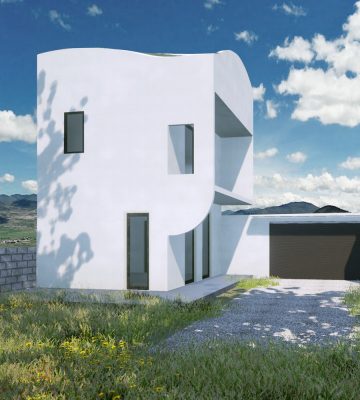
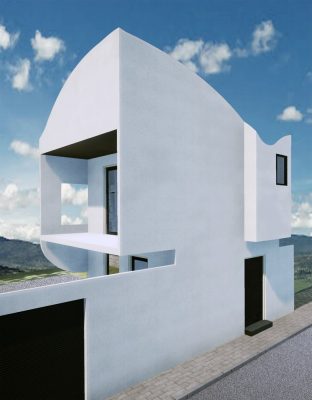
images © John Enright of Griffin Enright
Social Housing for Rural Mexico
SCI-Arc is pleased to announce that Mexico’s Institute of the National Fund for Workers’ Housing, (INFONAVIT) selected six SCI-Arc faculty to finalize designs addressing housing needs in a variety of environmental and economic climates across Mexico.
Jun 12 + 6, 2017
New SCI-Arc Exhibition
SCI-Arc Presents Thick by Maxi Spina: Opening July 7 in the SCI-Arc Gallery
SCI-ARC GALLERY EXHIBITION
Maxi Spina: Thick
July 7 – August 13, 2017
July 7, 7pm: Opening Reception
July 21, 7pm: Conversation with Maxi Spina + Hernan Diaz Alonso
Los Angeles, CA (June, 2017) – SCI-Arc is pleased to announce, Thick by Maxi Spina. Thickness is an increasingly elusive condition in architectural design. Alluded to in section, camouflaged in the figure-ground, and presented as a foil in the developable surface drawing, material thickness is an understudied architectural condition.
As a term, thickness does not refer to the actual solidity of a material (as in the standardization of sheet material or thickness of marble), but a conceptual and material problem that sits (literally) at the edge of architectural thinking. The condition of thickness—the necessity of thickness— carries no central import in any era of architectural thinking, but manages to circulate through different modes of architectural production.
Its condition is linked to (but is not central to) the history of stereotomy and stone construction; in the emergence of new forms of architectural drawing (developed surface drawing); and in the classic problem of the Doric order. Even in the Modernist obfuscation of solid form, it remains an unavoidable consideration in the Miesian corner and Kiesler’s endless surfaces.
In digital software, thickness is infinitely thin. Its default property is a single line or algorithmic curve. Its “thickness” must be added—it appears as an offset, an extrusion, an enclosed surface— as a mere afterthought. Thickness is a constructive problem as much as it is a representational one. In construction, it’s become synonymous with material offset (due to the predominance of sheet material), as opposite to stereotomy, in which thickness is derived from subtraction and removal of mass. Thickness becomes a tectonic default rather than a techne to be designed.
Thick attempts to expand on the problems of material thickness through the topic of sections, ruins, fragments, constructions, figurations, simultaneity, and representation. Coupled with a public discussion, the exhibition will expand on the problems of material thickness through the topic of sections, ruins, fragments, constructions, figurations, simultaneity, and representation.
Maxi Spina (b. Rosario, Argentina) is the co-founder of Spinagu (spinagu.com). He is currently Design Faculty and Applied Studies Faculty at SCI-Arc. He was previously the Maybeck Fellow at UC Berkeley, Lecturer at CCA and Associate Professor at Woodbury. His work has been featured in exhibitions at A+D Museum, Jai & Jai, Wuho Gallery. He received his M.Arch from Princeton University and a B.Arch from National University of Rosario, Argentina.
SCI-Arc Exhibition – Thick by Maxi Spina
Thick is supported in part by the Graham Foundation for Advanced Studies in the Fine Arts.
Thick is supported in part by the Formica Corporation.
Apr 14, 2017
SCI-Arc Presents The Duck and the Document Curated by Sylvia Lavin
The Duck and the Document: Stories of Postmodern Procedures
Curated by Sylvia Lavin
Associate Curator: Sarah Hearne
Exhibition Design: Besler & Sons
April 14 – May 28, 2017
April 14, 7pm: Opening Reception
The Duck and the Document features a series of fragments, from handrails to façade panels, salvaged from canonic buildings of the late 20th century.
Typically associated with drawing and the circulation of media images, postmodern architecture is generally understood to have been largely a matter of style and surface ornament, freed from the exigencies of political and technical systems by the force of architectural autonomy.
The Duck and the Document challenges this view by embedding the expected imagery of postmodernity within materials that demonstrate the dense tangle of regulations, production specifications and technologies that constrained architectural design rather than liberated it.
While these True Stories of Postmodern Procedures describe a less heroic and autonomous architect, they also produce a more persuasive account of architectural ingenuity as it sought to survive the bureaucratization not merely of the architectural profession but of the very idea of architecture. Featuring artifacts from the buildings and archives of Peter Eisenman, Deborah Sussman, Charles Moore, Mike Reynolds, SITE and others.
Sylvia Lavin is the Director of the Critical Studies M.A. and Ph.D. program in the Department of Architecture and Urban Design at UCLA, where she was Chairperson from 1996 to 2006, and the Director of The Curatorial Project, a collaborative design and research group that supports the critical engagement with experimental architecture in the public realm.
Ms. Lavin received her Ph.D. from the Department of Art and Archaeology at Columbia University in 1990 after having received fellowships from the Getty Center, the Kress Foundation and the Social Science Research Council.
The MIT Press published her first books Quatremère de Quincy and the Invention of a Modern Language of Architecture and Form Follows Libido: Architecture and Richard Neutra in a Psychoanalytic Culture in 1992 and 2005. Her most recent books include, Kissing Architecture, published by Princeton University Press in 2011 and Flash in the Pan, an AA publication.
Exhibitions curated by Ms. Lavin include The Artless Drawing: Works on Paper by Neil Denari, and Craig Hodgetts: Playmaker, at ACE Galleries, Los Angeles, Take Note: A Brief History of Conceptual Architecture at the Canadian Center for Architecture in Montreal and most recently Everything Loose Will Land. This large-scale examination of architecture and the arts in LA in the 1970s was a principal component of the Pacific Standard Time series supported by the Getty Foundation.
Everything Loose opened at the MAK/Schindler house in Spring 2013 and traveled to the Graham Foundation in 2014 after being shown at the Yale School of Architecture. Ms. Lavin has taught at Princeton University, Harvard’s GSD, Columbia University and elsewhere, writes frequently for Artforum, Log and Perspecta and is the recipient of an Arts and Letters Award in Architecture from the American Academy of Arts and Letters.
Feb 22, 2017
SCI-Arc Exhibition
SCI-Arc Gallery Exhibition + Symposium
Drawings’ Conclusions
Curator Jeffrey Kipnis
Producer Andrew Zago
March 10 – 25, 2017
Symposium
March 24, 6pm – 8pm
Keynote Speaker Peter Eisenman
March 25, 10am – 6pm
Closing Reception
Friday, March 24, 8pm
Los Angeles, CA (February 22, 2017) – SCI-Arc is pleased to announce, Drawings’ Conclusions, an exhibition curated by Jeffrey Kipnis and produced by Andrew Zago opening March 10 in the SCI-Arc Gallery. The exhibition is complemented by a two-day symposium March 24-25 featuring a keynote address by Peter Eisenman on Friday, March 24 at 6pm.
The exhibition asserts as self-evident that the constellation of hand architectural drawings reached an apex in its conceptual and technical development around 1990 just as computational technological instruments such as wireframe drawings, renderings page definition illustrations and 3-d models began to supplant its predecessor entirely as the primary vector for disciplinary and professional communication. Indeed, the anticipation of inevitable computational transformation, already forecast by film animation, scientific illustration and magazine graphics, fueled hand drawing’s last outburst of creative and technical development.
The exhibition is not an encyclopedic survey of that transition as such, but rather, in keeping with SCI-Arc’s unique pedagogical charter, it is an examination of a small group of architects, most just a few years out of graduate school at the time, who were then united by a precocious and deeply vested interest in the hand drawing, though each in his or her own, way – sometimes personal and idiosyncratic, sometimes conceptual and technically arcanely, and sometimes esoteric though stringent in drawing process. Each went on to negotiate the transition to the computational environment forthrightly and in highly original ways, maintaining a loyalty to their legacy without nostalgia in the new work.
In addition, the exhibition offers a small selection of a new generation of architects whose work, in the opinion of the curator, seems to keenly aware of the disciplinary legacy and vicissitudes of the hand drawing constellation, and desires to offer in its own way, again without nostalgia and with true originality, a continuing reflection on the question, what are drawing’s conclusions.
EXHIBITORS
Stan Allen Ben Nicholson
Andrew Atwood Phillip Parker
Kuta Ayata Jesse Reiser
Laura Bouwman Baharam Shirdel
Preston Scott Cohen Stephan Turk
Greg Lynn Nanako Umemoto
Elena Manferdini Michael Young
Anna Neimark Andrew Zago
SYMPOSIUM
Stan Allen Greg Lynn
Kelly Bair Elena Manferdini
Kristy Balliet Anna Neimark
Caroline Bos Jason Payne
Hernan Diaz Alonso Florencia Pita
Ramiro Diaz-Granados Jesse Reiser
Peter Eisenman (Keynote) Jonah Rowen
Todd Gannon Robert Somol
Thomas Kelley Devyn Weiser
Jeffrey Kipnis Andrew Zago
Jeffrey Kipnis is a visiting faculty at SCI-Arc and a professor of architecture at the Knowlton School where he teaches courses on architectural design and theory. For more than three decades, Kipnis’ work has shaped the thinking, imagination and creative work of architects and critics.
From seminal studies of the work of such key practitioners as Philip Johnson, Peter Eisenman, Rem Koolhaas and Daniel Libeskind, to theoretical reflections on the intellectual, cultural and political role of contemporary architecture in such essays as “Toward a New Architecture,” “Twisting the Separatrix” and “Political Space I,” to exhibitions on architectural drawing and design, Kipnis has brought a restless, generous and provocative originality to bear on the issues that have defined contemporary architecture.
Andrew Zago is principal of Zago Architecture, faculty at SCI-Arc, and clinical professor at the University of Illinois at Chicago. He holds a Bachelor of Fine Arts from the University of Michigan and a Master of Architecture from Harvard University. Over the course of thirty years he has built an international reputation for his insightful and groundbreaking contributions to architecture and architectural education.
Together with partner Laura Bouwman, Zago Architecture has consistently brought open-ended, creative inquiry to disciplinary concerns in architecture. Noted for its prescient articulation of emerging sensibilities, the practice weds aesthetic studies to the practical art of making buildings and cities. In doing so, Zago Architecture reaffirms the substantial and productive link amongst art, architecture and urbanism.
Jan 10, 2017
SCI-Arc 2017 Events
SCI-Arc Presents an Exhibition by José Oubrerie
LOS ANGELES, CA (January 9, 2017) – SCI-Arc is pleased to present José Oubrerie’s Chapel of Mosquitoes architecture and paintings, opening February 3, 2017 in the SCI-Arc Library. Oubrerie’s Chapel of Mosquitoes synthesizes the opposite spatial investigations of two of the architect’s most significant works: the 1986 French Cultural Center in Damascus and the 1992 Miller House in Lexington, Kentucky. The Chapel, planned for a site in upstate New York, becomes a contraction of these two projects yet retains attributes of both.
In the Chapel, the diagonal conduit that pierces roof and floor creates an axis between light and water and is reminiscent of the ladder in a kiva – the traditional community and meditative space of the Pueblo peoples in which the ladder not only allows access but also joins sky and earth. Yet, in the Chapel, there is no sipapu – the round hole of natural soil in the kiva’s pavement through which the spirits of the ancients can exude. Instead, the ground is visible beyond the floor, which retracts to allow the natural ground to enter the interior and also extends to integrate the interior space with the exterior.
The coexistence of interior and exterior, together with the sunlight and rainwater descending from the sky, reminds us of the elemental aspects of being human and that, for us, there is only ONE EARTH.
About José Oubrerie
José Oubrerie is Professor Emeritus at the Knowlton School of Architecture at The Ohio State University, where he was Chair from 1991 to 1997.
Initially trained as a painter, Oubrerie studied architecture at the École des Beaux-Arts in Paris. In 1958, he joined the Atelier Le Corbusier, where he was involved in projects including the Strasbourg Convention Center, the Venice Hospital, and the church of St. Pierre de Firminy-Vert. After Corbusier’s death in 1965, he formed a brief partnership with Guillermo Jullian de la Fuente to complete design development of the Venice Hospital. In 1967, he launched Atelier José Oubrerie in Paris.
Oubrerie relocated to the United States in the early 1980’s and formed his current practice, Atelier Wylde-Oubrerie, in 1989. His many acclaimed projects include the French Cultural Center in Damascus, the Miller House in Lexington, Kentucky, and the completion of the Firminy Church in 2006.
Long celebrated for his contributions to architectural education, Oubrerie has taught at the Cooper Union, Columbia University, the University of Kentucky (where he was Dean from 1987 to 1991), and Ohio State. He is currently visiting professor at the University of Illinois at Chicago.
His work has been published or exhibited worldwide and recognized with awards from institutions including the French Academy of Architecture, the AIA, the French Ministry of Construction, and the French Ministry of Culture, which promoted him to the rank of Chevalier des Arts et des Lettres in 2009.
Dec 22, 2016
SCI-Arc Launches spring 2017 series of public events
Events at SCI-Arc are always free and open to the public
SCI-ARC ANNOUNCES SPRING 2017 PUBLIC LECTURES AND EXHIBITIONS
Los Angeles, CA (December 21, 2016) m- SCI-Arc is pleased to announce its spring 2017 series of public events. SCI-Arc public lectures this coming spring will introduce speakers from a broad cross-section of today’s most exciting architects, artists, philosophers and theorists including José Oubrerie, Slajov Žižek and Sylvia Lavin, among others.
The lecture series is complemented by several exhibitions including: Curated by Sylvia Lavin, The Duck and the Document features a series of fragments, from handrails to façade panels, salvaged from canonic buildings of the late 20th century. Curated by Jeffrey Kipnis and designed by Andrew Zago, Drawing Conclusions asserts as self-evident that the constellation of hand architectural drawings reached an apex in its conceptual and technical development around 1990 just as computational technological instruments such as wireframe drawings, renderings page definition illustrations and 3-d models began to supplant its predecessor entirely as the primary vector for disciplinary and professional communication.
Admission to SCI-Arc-hosted public events and exhibitions is always free and open to the public.
January 25 Didier Fiuza Faustino Lecture
February 1 Mat Olson Lecture
February 3 José Oubrerie: Chapel of the Mosquitos Library Gallery Exhibition Opening
February 6 José Oubrerie + Todd Gannon Duel + Duet
March 1 Graham Harman + Slajov Žižek Duel + Duet
March 8 Peter Cook Lecture
March 15 Neil M. Denari Lecture
March 20 Jeffrey Schnapp Lecture
March 24-25 Drawing Conclusions Symposium + Exhibition Closing Reception
March 29 Sylvia Lavin Lecture
April 3 Jake Matatyaou + Amalia Ulman Lecture
April 5 Giancarlo Mazzanti Lecture
April 14 The Duck and the Document SCI-Arc Gallery Exhibition Opening Reception
April 29 Spring Show Exhibition Opening Reception
June 16 Maxi Spina: Thick SCI-Arc Gallery Exhibition Opening Reception
Visit http://sciarc.edu/events/ for more information about upcoming lectures.
All events begin at 7pm unless otherwise noted.
Lectures take place in the W. M. Keck Lecture Hall and are broadcast at www.sciarc.edu/live.
Gallery opening receptions are held in the SCI-Arc Gallery & Kappe Library Gallery spaces.
Didier Faustino:
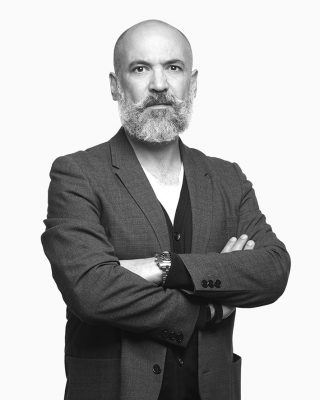
photo : Valerie Le Guern
January 25, 7pm in the W.M. Keck Lecture Hall
Didier Fiuza Faustino Lecture
Didier Faustino is an architect and artist working on the relationship between body and space. He started his own practice at the crossroad of art and architecture just after graduating in architecture in 1995. His projects are characterized by their critical perspectives, their freedom of codes and their ability to offer new experiences to the individual and collective body.
Didier Faustino is currently dedicating his time between architecture (Spain, Mexico City, Portugal), art (with exhibitions in Paris, London and Rome) and teaching (AA School, Diploma Unit 2). He is also the editor in chief of the French architecture and design magazine CREE. In some of his iconic works, such as Body in Transit (Venice Biennale, 2000), a minimal space critiquing the transport of illegal immigrants, or One Square Meter House (Paris, 2007), a building prototype questioning the notions of land value and ownership, Faustino’s subversive stance invites us to question the political role of creation as well as our own position as a subject and a citizen.
February 1, 7pm in the W.M. Keck Lecture Hall
Matt Olson Lecture
Matt Olson established OOIEE (Office Of Interior Establishing Exterior) on 1/1/16 to work on projects related to contemporary art, design and culture. It is a cross-disciplinary, open practice with interests ranging from furniture and objects, actions and scenarios, landscape architecture related work, teaching, writing, publishing, fashion and more. From 2003 to 2015 he was cofounder and creative director of RO/LU.
His work has been shown internationally and resides in the permanent collection of the Walker Art Center, as well as many esteemed private collections. He was featured in the book form compendium of the PIN-UP Magazine Interviews and was artist-in-residence at the Robert Rauschenberg Foundation. He’s based in St Paul, MN, where he teaches “Towards A Cross Disciplinary, Open Practice” in the School of Architecture at the U of M. In 2016 OOIEE completed projects at the Aspen Art Museum, Etage Projects in Copenhagen and was a visiting artist and lecturer at Cranbrook.
February 6, 7pm in the W.M. Keck Lecture Hall
José Oubrerie + Todd Gannon Duel + Duet
José Oubrerie is Professor Emeritus at the Knowlton School of Architecture at The Ohio State University, where he was Chair from 1991 to 1997. Initially trained as a painter, Oubrerie studied architecture at the École des Beaux-Arts in Paris. In 1958, he joined the Atelier Le Corbusier, where he was involved in projects including the Strasbourg Convention Center, the Venice Hospital, and the church of St. Pierre de Firminy-Vert.
After Corbusier’s death in 1965, he formed a brief partnership with Guillermo Jullian de la Fuente to complete design development of the Venice Hospital. In 1967, he launched Atelier José Oubrerie in Paris. Oubrerie relocated to the United States in the early 1980s and formed his current practice, Atelier Wylde-Oubrerie, in 1989. His many acclaimed projects include the French Cultural Center in Damascus, the Miller House in Lexington, Kentucky, and the completion of the Firminy Church in 2006. Long celebrated for his contributions to architectural education, Oubrerie has taught at the Cooper Union, Columbia University, the University of Kentucky (where he was Dean from 1987 to 1991), and Ohio State.
He is currently visiting professor at the University of Illinois at Chicago. His work has been published or exhibited worldwide and recognized with awards from institutions including the French Academy of Architecture, the AIA, the French Ministry of Construction, and the French Ministry of Culture, which promoted him to the rank of Chevalier des Arts et des Lettres in 2009.
Todd Gannon is an architect and writer based in Los Angeles. He teaches history, theory, and design studio at SCI-Arc. His published books include The Light Construction Reader (2002), Et in Suburbia Ego: José Oubrerie’s Miller House (2013) and monographs on the work of Morphosis, Bernard Tschumi, UN Studio, Steven Holl, Mack Scogin/Merrill Elam, Zaha Hadid, Peter Eisenman and Eric Owen Moss. His essays have appeared in The Routledge Companion for Architecture Design and Practice (2015), The SAGE Handbook for Architectural Theory (2012), and in periodicals including Log, The Architect’s Newspaper, and Offramp.
In collaboration with Ewan Branda and Andrew Zago, he curated the 2013 SCI-Arc Gallery exhibition A Confederacy of Heretics. His work has been recognized and supported by the Getty Foundation, the Graham Foundation, the National Endowment for the Arts, the American Institute of Architects, the City of Los Angeles Department of Cultural Affairs, The Ohio State University, and UCLA.
March 1, 7pm in the W.M. Keck Lecture Hall
Graham Harman + Slajov Žižek Duel + Duet
Graham Harman is Distinguished Professor of Philosophy at SCI-Arc. He was born in 1968 in Mt. Vernon, Iowa, and earned his B.A. from St. John’s College (Maryland), his M.A. from Penn State University, and his Ph.D. from DePaul University. He is the author of fifteen books, most recently Immaterialism: Objects and Social Theory (2016, Polity) and Dante’s Broken Hammer: The Ethics, Esthetics, and Metaphysics of Love (2016, Repeater). Graham is the 2009 winner of the AUC Excellence in Research Award. In 2015 he was named by ArtReview in 2015 as the #75 most powerful influence in the international art world, and in 2016 was named by The Best Schools to their alphabetical list of the 50 most influential living philosophers.
Slavoj Žižek, researcher at the Department of Philosophy, University of Ljubljana; researcher at the Birkbeck School of Law, London University; visiting professor at Kyuing-Hee University, Seoul. His work focuses on the philosophical implications of psychoanalytic theory, especially on the way a Lacanian reading of Hegel enables us to overcome the opposition between realism and transcendentalism. Latest publications: DISPARITIES (Bloomsbury Press 2016), ANTIGONE (Bloomsbury Press 2016), AGAINST THE DOUBLE BLACKMAIL (Penguin Books 2015).
March 8, 7pm in the W.M. Keck Lecture Hall
Peter Cook Lecture
Professor Sir Peter Cook RA, founder of Archigram, former Director the Institute for Contemporary Art, London (the ICA) and Bartlett School of Architecture at University Col¬lege, London has been a pivotal figure within the global architectural world for over half a century. His ongoing contribution to architectural innovation was most recent¬ly recognized via the conferral of an honorary doctorate in April 2010, by the University of Lund, Sweden.
Peter’s achievements with radical experimentalist group Archigram have been the subject of numerous publica¬tions and public exhibitions and were recognized by the Royal Institute of British Architects in 2004, when mem¬bers of the group were awarded the RIBA’s highest award, the Royal Gold Medal. In 2007, Peter was knighted by the Queen for his services to architecture. He is also a Royal Academician and a Commandeur de l’Ordre des Arts et Lettres of the French Republic. Peter is currently a Senior Fellow of the Royal College of Art, London. His professorships include those of the Royal Academy, University College, London and the Hochschule fur Bildende Kunste (Staedelschule) in Frankfurt-Main, Germany.
March 15, 7pm in the W.M. Keck Lecture Hall
Neil M. Denari Lecture
Neil M. Denari, FAIA, is principal of NMDA, Neil M. Denari Architects Inc., and Professor of Architecture and Interim Chair of the AUD at UCLA. He received his BArch from the University of Houston in 1980 and an MArch from Harvard in 1982. Among his many awards is the Los Angeles AIA Gold Medal, received in 2011. His work has been included in many exhibitions, including the solo show “The Artless Drawing” in 2010 at Ace Gallery LA and the 2013 group show New Sculpturalism at MOCA Los Angeles.
His work is permanently held by eight major museums around the world. With NMDA, Denari works on building projects in North America, Europe and Asia. In 2012, NMDA won first prize in the New Keelung Harbor Service Building competition. Denari lectures worldwide and has been a Visiting Professor at Harvard, Princeton, Columbia, and UC Berkeley among other schools and was the Director of SCI-Arc from 1997-2002. He is the author of Interrupted Projections (1996), Gyroscopic Horizons (1999), and Mass X forthcoming in 2017.
March 20, 7pm in the W.M. Keck Lecture Hall
Jeffrey Schnapp Lecture
Jeffrey Schnapp is a cultural theorist, media historian, designer, and experimentalist. He teaches at Harvard University and is the founder/faculty director of metaLAB (at) Harvard, faculty co-director of the Berkman Klein Center for Internet and Society, and CEO of Piaggio Fast Forward. Among his recent books are The Electric Information Age Book (2012), Modernitalia (2012), The Library Beyond the Book (2014), Blueprint for Counter Education — Expanded Reprint (2016; a reprint edition of Maurice Stein and Larry Miller’s 1970 work of radical pedagogy); and the bolted book Future Piaggio: Six Italian Lessons on Mobility and Modern Life (2017).
March 29, 7pm in the W. M. Keck Lecture Hall
Sylvia Lavin Lecture
Sylvia Lavin is an internationally known critic, historian and curator whose work explores the limits of architecture across a wide spectrum of historical periods. She is Professor, Director of PhD Programs and former Chair of the Department of Architecture and Urban Design at UCLA and has taught at Princeton, Harvard, Columbia among other schools. She is a frequent contributor to journals such as Artforum, Perspecta and Log and among her books are titles such as Form Follows Libido: Architecture and Richard Neutra in a Psychoanalytic Culture, Kissing Architecture and Flash in the Pan. Recent exhibitions include Everything Loose Will Land: Art and Architecture in Los Angeles in the 1970s, The New Creativity and The Artless Drawing. She has been recognized by many grants and awards, most recently from the American Academy of Arts and Letters, the Getty Research Institute and the Graham Foundation.
April 3, 7pm in the Library
Jake Matatyaou + Amalia Ulman Duel + Duet
Jake Matatyaou is a designer and educator based in Los Angeles, California. Motivated by exchanges between aesthetics and politics, his work addresses questions of material and immaterial modes of cultural production and reception. Matatyaou received a B.A. in Economics and Political Science from UCLA in 2001, a Ph.D. from the Department of Political Science at Northwestern University in 2008, and an M.Arch from Columbia University’s Graduate School of Architecture, Planning and Preservation in 2012. He has worked in the offices of Leong Leong Architects, Bernard Tschumi Architects, and is a founding partner of the design practice JuneJuly. He is the liberal arts coordinator and design faculty at SCI-Arc.
The work of artist Amalia Ulman operates within the triangle of commerce, leisure, and popular culture, exposing the commodification of everyday life. The personas, artifacts, and environments Ulman creates confuse one’s sense of reality and invite us to take a closer look at the promiscuous power of images as they acquire the phantasmagoric capacity to circulate on their own.
April 5, 7pm in the W.M. Keck Lecture Hall
Giancarlo Mazzanti Lecture
Giancarlo Mazzanti (1963, Barranquilla, Colombia) is an architect and graduated from the Javeriana University, Bogotá – Colombia (1987) with a postgraduate degree in Architecture History and theory, and Industrial Design from the University of Florence, Italy (1991). He has taught at several Colombian universities, and has taught at some of the most prestigious American universities such as Princeton University in 2012, Harvard Graduate School of Design in 2014 and University of Pennsylvania in 2016.
He has been invited to lecture at Pratt, Yale, Berkeley, University of Valencia, Monterrey, Buenos Aires, Catolica del Peru, MIT, Tulane and Strelka, among others. Amongst some of his most relevant projects are the Convention Center, Biblioteca España, the South American Games Coliseums in Medellín, Colombia, the Tercer Milenio Park, El Porvenir Kindergarten in Bogota, Timayu Kindergarten in Santa Marta and most recently Pies Descalzos School in Cartagena and Marinilla Educational Park.
He has been the distinguished winner of the XX Colombian Architecture Biennial in the category of public space in 2006, the Ibero-American Biennial in the category of Best Architectonic Work in 2008 (Lisbon, Portugal), winner of the Panamerican Architecture Biennial in the category of Architectonic Design in 2008 (Quito, Ecuador) and received the Global Award for Sustainable Architecture (Paris, France) in 2010. His work is in the permanent collection of MoMA (New York), Museum Georges Pompidou (Paris) and CMOA (Pittsburgh). Most of his architecture work involves social values at its main core; it searches for projects that empower transformations and build community.
EXHIBITIONS
February 3 – March 5, 2017 in the Library Gallery
José Oubrerie: Chapel of the Mosquitos Exhibition
Friday, February 3, 7pm: Opening Reception
José Oubrerie’s Chapel of the Mosquitoes synthesizes the opposite spatial investigations of two of the architect’s most significant works: the 1986 French Cultural Center in Damascus and the 1992 Miller House in Lexington, Kentucky. The Chapel, planned for a site in upstate New York, becomes a contraction of these two projects yet retains attributes of both. In the Chapel, the diagonal conduit that pierces roof and floor creates an axis between light and water and is reminiscent of the ladder in a kiva – the traditional community and meditative space of the Pueblo peoples in which the ladder not only allows access but also joins sky and earth. Yet, in the Chapel, there is no sipapu – the round hole of natural soil in the kiva’s pavement through which the spirits of the ancients can exude. Instead, the ground is visible beyond the floor, which retracts to allow the natural ground to enter the interior and also extends to integrate the interior space with the exterior. The coexistence of interior and exterior, together with the sunlight and rainwater descending from the sky, reminds us of the elemental aspects of being human and that, for us, there is only ONE EARTH.
José Oubrerie is Professor Emeritus at the Knowlton School of Architecture at The Ohio State University, where he was Chair from 1991 to 1997. Initially trained as a painter, Oubrerie studied architecture at the École des Beaux-Arts in Paris. In 1958, he joined the Atelier Le Corbusier, where he was involved in projects including the Strasbourg Convention Center, the Venice Hospital, and the church of St. Pierre de Firminy-Vert. After Corbusier’s death in 1965, he formed a brief partnership with Guillermo Jullian de la Fuente to complete design development of the Venice Hospital. In 1967, he launched Atelier José Oubrerie in Paris. Oubrerie relocated to the United States in the early 1980s and formed his current practice, Atelier Wylde-Oubrerie, in 1989. His many acclaimed projects include the French Cultural Center in Damascus, the Miller House in Lexington, Kentucky, and the completion of the Firminy Church in 2006.
Long celebrated for his contributions to architectural education, Oubrerie has taught at the Cooper Union, Columbia University, the University of Kentucky (where he was Dean from 1987 to 1991), and Ohio State. He is currently visiting professor at the University of Illinois at Chicago. His work has been published or exhibited worldwide and recognized with awards from institutions including the French Academy of Architecture, the AIA, the French Ministry of Construction, and the French Ministry of Culture, which promoted him to the rank of Chevalier des Arts et des Lettres in 2009.
March 10 – 25, 2017 in the SCI-Arc Gallery
Drawing Conclusions Symposium & Exhibition
Curated by Jeffrey Kipnis and Produced/Designed Andrew Zago
Friday, March 24, 7pm: Exhibition Closing Reception
Friday, March 24 and Saturday, March 25: Symposium
Drawing Conclusions asserts as self-evident that the constellation of hand architectural drawings reached an apex in its conceptual and technical development around 1990 just as computational technological instruments such as wireframe drawings, renderings page definition illustrations and 3-d models began to supplant its predecessor entirely as the primary vector for disciplinary and professional communication. Indeed, the anticipation of inevitable computational transformation, already forecast by film animation, scientific illustration and magazine graphics, fueled hand drawing’s last outburst of creative and technical development.
The exhibition is not an encyclopedic survey of that transition as such, but rather, in keeping with SCI-Arch’s unique pedagogical charter, it is an examination of a small group of architects, most just a few years out of graduate school at the time, who were then united by a precocious and deeply vested interest in the hand drawing, though each in his or her own, way – sometimes personal and idiosyncratic, sometimes conceptual and technically arcanely, and sometimes esoteric though stringent in drawing process.
Each went on to negotiate the transition to the computational environment forthrightly and in highly original ways, maintaining a loyalty to their legacy without nostalgia in the new work. In addition, the exhibition offers a small selection of a new generation of architects whose work, in the opinion of the curator, seems to keenly aware of the disciplinary legacy and vicissitudes of the hand drawing constellation, and desires to offer in its own way, again without nostalgia and with true originality, a continuing reflection on the question, what are drawing’s conclusions.
Andrew Zago is principal of Zago Architecture, faculty at SCI-Arc, and clinical professor at the University of Illinois at Chicago. He holds a Bachelor of Fine Arts from the University of Michigan and a Master of Architecture from Harvard University. Over the course of thirty years he has built an international reputation for his insightful and groundbreaking contributions to architecture and architectural education. Together with partner Laura Bouwman, Zago Architecture has consistently brought open-ended, creative inquiry to disciplinary concerns in architecture. Noted for its prescient articulation of emerging sensibilities, the practice weds aesthetic studies to the practical art of making buildings and cities. In doing so, Zago Architecture reaffirms the substantial and productive link amongst art, architecture and urbanism.
April 14 – May 28, 2017 in the SCI-Arc Gallery
The Duck and the Document Exhibition
Curated by Sylvia Lavin
Friday, April 14, 7pm: Exhibition Opening Reception
The Duck and the Document features a series of fragments, from handrails to façade panels, salvaged from canonic buildings of the late 20th century. Typically associated with drawing and the circulation of media images, postmodern architecture is generally understood to have been largely a matter of style and surface ornament, freed from the exigencies of political and technical systems by the force of architectural autonomy. The Duck and the Document challenges this view by embedding the expected imagery of postmodernity within materials that demonstrate the dense tangle of regulations, production specifications and technologies that constrained architectural design rather than liberated it. While these True Stories of Postmodern Procedures describe a less heroic and autonomous architect, they also produce a more persuasive account of architectural ingenuity as it sought to survive the bureaucratization not merely of the architectural profession but of the very idea of architecture. Featuring artifacts from the buildings and archives of Peter Eisenman, Charles Moore, Mike Reynolds, SITE and others.
April 29 – May 29, 2017 throughout School
Spring Show
Saturday, April 29, 5pm: Opening Reception
SCI-Arc’s eleventh annual Spring Show follows the Undergraduate Thesis and features student work from all school programs. Undergraduate, Graduate and Postgraduate design studio projects, as well as coursework from the Applied, Cultural and Visual Studies seminars, are exhibited schoolwide.
June 16 – July 31, 2017 in the SCI-Arc Gallery
Maxi Spina: Thick Exhibition
Friday, June 16, 7pm: Opening Reception
Alluded to in section, camouflaged in the figure-ground, and presented as a foil in the developable surface drawing, material thickness is an understudied architectural condition that has served as an elusive site for many acts of design. Thick is a research project that explores material thickness as a site of an architectural investigation that seeks evidence in the strong interaction between the representational and the material. The project culminates with a two-month exhibition in the SCI-Arc gallery space, featuring new work by Maxi Spina.
The exhibition is spatial, operating within / between / through the literal walls of the gallery, as well as operational, producing a collection of fragments that explores the section as an operative act through which figuration and form emerge. Coupled with a workshop series, catalogue and public discussion, the exhibition will expand on the problems of material thickness through the topic of sections, ruins, fragments, constructions, figurations, simultaneity, and representation.
Maxi Spina is a graduate of the National University of Rosario (B.Arch with Honors) and Princeton University (M.Arch). He taught at UC Berkeley (where he earned a Maybeck Fellowship), CCA, Woodbury and UNR, before joining SCI-Arc, where he teaches Design Studio and Applied Studies.
In 2007 he founded Maxi Spina Architecture, a design office in Los Angeles. MSA’s work foregrounds the realm of the drawing as the space conceptually and aesthetically responsible for the formal and material constitution of the architectural object and the sensory world created by it. Spina is the recipient of numerous accolades from the Chicago Athenaeum, AIA-LA, Architect Magazine and ACSA; a finalist in Architizer A+ Awards; and recipient of three Maxine Frankel Awards for Research. Maxi’s work has been exhibited in Wurster Gallery in Berkeley, A+D Museum, WUHO and Jai & Jai in Los Angeles. Maxi has worked for Neil M. Denari Architects and Studio Daniel Libeskind.
SCI-Arc News Archive
SCI-Arc Events 2018, Los Angeles
SCI-Arc Los Angeles Events 2016
Hypostyle Installation – March 3rd, 2015:
Wolf Prix, Coop Himmelb(l)au, Vienna: Dalian International Conference Center, Dalian, China, 2008-2012:
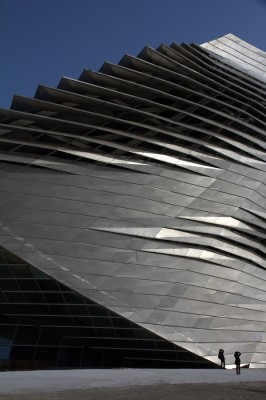
photo from architects via SCI-ARC
Architects associated with SCI-Arc
Frank Gehry, Architect, Gehry Partners, LLP, Los Angeles
Eric Owen Moss
SCI-Arc Spring Show:
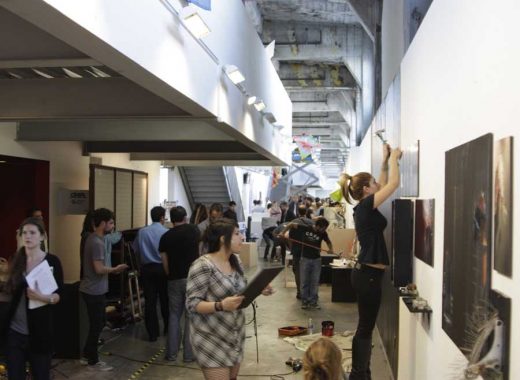
photo from SCI-Arc
SCI-Arc Mexico City – 2016
SCI Arc Architecture News 2010-2011
SCI Arc Architecture Lectures 2009
Location: 960 E 3rd St, Los Angeles, CA 90013, USA
Los Angeles, Southern California, United States of America
Los Angeles Buildings
Contemporary Los Angeles Architecture
L.A. Architecture Designs – chronological list
Los Angeles Architecture Tours – architectural walks by e-architect
Drawing Show Exhibition at A+D Museum Los Angeles
SCI-Arc Exhibition : L.A. in Wien / Wien in L.A.
Los Angeles Architecture Designs
SCI-Arc Atelier Hitoshi Abe Exhibition
SCI-Arc Competition : Contest 2010
SCI-Arc Distinguished Alumni Awards
Comments / photos for the SCI-Arc Events 2017 Archive Los Angeles page welcome
Website: www.sciarc.edu


